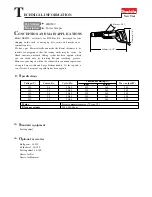
Model t10222 (Mfg. since 12/09)
-19-
to reduce the likelihood of kickback when free-
hand routing, use a starting pin or block (see
figures 26–
27
). this will allow you to anchor and
slowly pivot the workpiece into the cutter as the
cut is started, making the operation more stable
and safe.
figure
27
. Example of using a jig with a starting
block.
ALWAyS use an auxiliary jig and extreme care
when free-hand routing that requires remov-
al of the fence. Routing without the fence
and the attached guard greatly increases the
risk of accidental contact with the spinning
cutter, causing serious personal injury.
To free-hand route:
1. disConnECt routEr FroM poWEr!
2. Fabricate a jig to use with the workpiece that
will match the desired finished shape, then
attach it to the workpiece (see
figure
27
for
an example).
Note:
Make sure any fasteners used will not
make contact with the router bit during the
cutting operation. Glue can be used as an
alternative.
3. remove the fence assembly from the table.
4. if possible, fabricate and mount a custom
guard over the bit that safely protects your
hands from the spinning cutter.
5. insert the starting pin in the best suited hole
on the routing table or clamp a starting block
to the table (see
figure
27
for an example).
6. install a router bit with a rub collar as directed
by the router manufacturer's instructions,
then raise it to the desired height (see
figure
28
).
Rub
Collar
Workpiece
Template
figure
28
. using a template and rub collar for
free-hand routing.








































